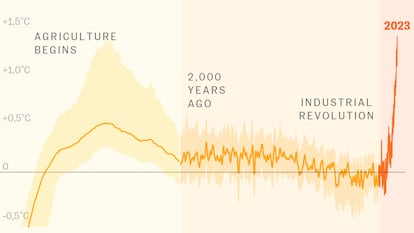2023 is the hottest year in millennia: Why and how is this measured?
An analysis of the evolution of the planet’s climate can be made by following the human carbon footprint, as well as the traces left by rising temperatures in tree rings, ice and sediment

There are still some days left in December, but it’s already clear that 2023 will be the hottest year ever recorded on Earth. This is according to a report released this past Wednesday by the Copernicus Climate Change Service (C3S) of the European Commission. From January to November of 2023, the planet’s average temperature has been 1.46 degrees Celsius above pre-industrial levels.
To understand the seriousness of what’s happening, we must scientifically analyze which point in the past year was the hottest. We must also look at what has influenced the increase in temperature over the past year: the carbon emissions of humans, the phenomenon of El Niño, along with other factors that are being studied, such as the Hunga Tonga volcanic eruption, or changes in maritime transport fuels. EL PAÍS affirms that human beings, by far, have influenced these record-high temperatures.
Since records have been kept, there hasn’t been a warmer year than 2023. Copernicus and other environmental agencies place the starting point at 1850, which is when there began to be observations made with measuring instruments, allowing for a reliable calculation of the planet’s average temperature.
The year 2023 has been warmer — on a planetary scale — than any of the previous 173 years. However, you can still go much further back in time. There are no thermometer records to compare, but estimates can be made through the field of paleoclimatology: the science that reconstructs the climate of the past, examining indications in tree rings, ice and sediment.
The Intergovernmental Panel on Climate Change (IPCC) — the main reference for climate science — noted in its sixth scientific review that the current warming is also unprecedented when compared to the last 2,000 years, beyond the beginning of the Middle Ages. There’s little doubt that this is the case, based on the studies of tree rings. However, we can still go further back, to the last 11,000 years. This is the period known as the Holocene, when agriculture and human civilization developed. “It can be said that the current era is warmer than the last 2,000 or 2,500 years and that it’s surely warmer than the Holocene,” affirms Ernesto Tejedor, a paleoclimatologist at Spains’ National Museum of Natural Sciences, who works with trees.
“In paleoclimatology, we use indirect records. [We’re not relying on] thermometers or pluviographs, which means that we have uncertainties, but the tree rings are the most accurate,” Tejedor tells EL PAÍS. He explains that the thickness of the rings varies due to the growth of the trees depending on the temperature or rainfall. In Spain, for instance, the most reliable reconstructions of past climatic periods are made with ancient trees from the Pyrenees, where wood growth isn’t limited by water, but by heat. A 2021 study published in Nature Communications — which Tejedor participated in — concluded that the current period is the warmest in the last 2,500 years. This was determined by utilizing an average of reconstruction methods from 15 different research groups around the world, which examined the oldest tree sites in the Northern Hemisphere.
For the entire 11,000-year period of the Holocene, there aren’t many records, nor can the climate be reconstructed year by year with just trees. As we move further into the past, other time scales are used, including centuries or millennia. But everything indicates that current temperatures continue to be warmer. As the Earth once went through a long glacial period, there are even scientists who assure the public that 2023 has been the warmest year in the past 125,000 years. However, there are many more uncertainties with this theory.
In any case, going so far back in time is also of relative interest. In the history of the Earth — since its creation 4.5 billion years ago — there have been much warmer phases than now. However, Juan Jesús González Alemán — a meteorologist and climate researcher — emphasizes that the important thing is to see how the climate in which humans have thrived changes. “The Earth doesn’t care about this warming. What’s at stake is the way of life of human civilization,” the meteorologist emphasizes.
Climate change and natural variations
So why is 2023 the warmest year? Well, to understand the reasons, the first thing to keep in mind is that this year isn’t an exception. Rather, it’s part of a climate change trend that the planet is experiencing. The last nine years (2015-2023) are the warmest on record. To find the warmest year before 2023, we don’t have to go far back: it was 2016.
1. Global warming caused by humans.
The main reason for this record hot year is, undoubtedly, climate change. If the global warming caused by human activities didn’t exist, this maximum could hardly have been recorded in 2023 or in the previous eight years. Currently, the planet is about 1.1 degrees Celsius warmer compared to pre-industrial levels (taking the decade 2011-2020 as a reference and comparing it with the 1850-1900 period).
Using the Industrial Revolution as a reference point when analyzing climate change isn’t random. It’s from that moment onwards that humans began to burn fossil fuels in massive quantities to feed the world’s growing economy. Coal came first, before oil and gas were added to the mix. These fuels emit most of the greenhouse gasses that build up in the atmosphere and retain heat.
The Earth’s atmosphere has always contained these gasses, which allow for the planet to have an acceptable temperature for humans and animals. However, with the massive burning of fossil fuels, the balance is broken. In just a few decades, more carbon has been released than in the past thousands and thousands of years.
The IPCC — in its last major review — estimated that the contribution of greenhouse gasses to global warming has been between one and two degrees Celsius since the pre-industrial era. But a part of this increase in temperature — up to 0.8 degrees — has been offset by the aerosols that humans have also expelled, which have a cooling effect. The influence of other natural drivers — such as solar radiation and volcanoes — has barely had an impact of 0.1 degrees, according to IPCC calculations.
In conclusion, the main factor in the record heat of 2023 is greenhouse gasses. And, among all of these gasses, the one that has the most influence on the climate is carbon dioxide (CO₂). Approximately half of the emissions of this gas are retained by vegetation and the ocean. The remaining 50% ends up in the atmosphere, where it remains for centuries. The air concentration of this gas (whose main origin is fuel, although deforestation also contributes) reached 417.9 parts per million in 2022, or 50% more than in 1750, according to data from the World Meteorological Organization.
To find a similar concentration, you have to go back between 800,000 and two million years. As detailed by Ana Moreno — a paleoclimatologist at the Pyrenean Institute of Ecology, who reconstructs the climate from stalagmites — it’s much easier to reconstruct the evolution of CO₂ in the atmosphere than that of temperature. “Never in a period of a million years has CO₂ in the atmosphere approached today’s levels. With CO₂, [we can clearly determine this]: an air bubble is punctured in the ice and it’s measured,” the scientist affirms, specifying how, “with isotopes, you can even differentiate the CO₂ that comes from the respiration of plants from the CO₂ that’s emitted from the burning of fossil fuels.”
The second-most important greenhouse gas is methane, which has a more powerful warming effect than carbon dioxide, although methane only remains in the atmosphere for a decade. Approximately 40% of methane is emitted by natural sources (such as wetlands), while the other 60% is caused by activities linked to humans, such as livestock farming or fuel production. The last of the most important greenhouse gasses is nitrous oxide, 40% of which comes from anthropogenic sources. This also depletes the ozone layer. The concentration of methane and nitrous oxide in the atmosphere is also at a record high. We must go back 800,000 years to find a similar level, according to the IPCC.
2. El Niño
The planet’s average temperatures were already above average in the first-half of the year. But starting in the summer, they skyrocketed to the point that, on July 6, the highest daily global temperature on record was recorded: 17.2 degrees Celsius. Starting in June, the phenomenon of El Niño began, a natural pattern that causes water surface temperatures in the tropical areas of the Pacific Ocean to increase, which ends up having effects on the global climate. It’s expected to continue until at least the spring of 2024, making it potentially another record-breaking year. The previous annual temperature record in 2016 coincided with El Niño.
The influence of this pattern is well-studied, Buontempo explains. La Niña is also studied: this phenomenon does the opposite of El Niño, actually lessening global warming. “But it’s not just El Niño. We’re also seeing heat waves in the North Atlantic, heat waves in Europe,” says Bountempo.
A phenomenon that has surprised scientists is the unusually high temperature in Antarctica, with high rates of ice melting. Buontempo acknowledges that, at the moment, it’s difficult to explain this.
3. Solar cycles
The influence of increased solar activity has also been pointed out. About every 11 years, the Sun oscillates between dormancy and an active period, marked by sunspots and eruptions, or flares and plasma explosions. It’s now in the active phase. In any case, this has a very small effect on global warming, as the main factor is, undoubtedly, the activity of human beings and the gasses they expel.
4. The underwater volcano
According to the director of the Copernicus Climate Change Service, in the case of the eruption of the Hunga Tonga-Hunga Ha’apai volcano in early-2022, the influence on rising temperatures isn’t clear. Typically, volcanoes contribute to the planet’s cooling by injecting sulfur into the atmosphere. However, this underwater volcano expelled enormous amounts of water vapor, which could have contributed to warming, as the Berkeley Earth organization pointed out in October of 2023. “I’ve seen reports that say the volcano increased temperatures and others that say it cooled them,” Buontempo summarizes.
The eruption of the Hunga Tonga volcano injected approximately 150 million tons of water vapor into the stratosphere

Source: Joshua Stevens/NASA Earth Observatory.
5. Maritime fuels
There’s also a lot of uncertainty about the influence that the new international standards on fuels in maritime transport may be having on rising temperatures. This has resulted in a drastic reduction in sulfur emissions, which could have an influence on the high temperatures being recorded in the North Atlantic.
Beyond current or sporadic issues, Buontempo clearly affirms what the underlying problem is: “As long as greenhouse gas concentrations continue to increase, we cannot expect results that are any different from those observed this year.” The hottest year ever recorded.
Sign up for our weekly newsletter to get more English-language news coverage from EL PAÍS USA Edition
More information

